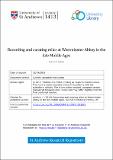Recording and curating relics at Westminster Abbey in the late Middle Ages
Abstract
Westminster Abbey’s relics, and objects functionally related to them, were kept in the shrine chapel of St Edward the Confessor, where the kings and queens of England were customarily buried. They constituted a discrete collection, curated by a dedicated monastic officer titled ‘the keeper of St Edward’s shrine and the relics of St Peter’s church’. Inventories of the chapel, made when the office changed hands, survive from 1467, 1479 and 1520. These documents are analysed here for what they reveal of the contents of the collection, monastic interest in it, and the way the relics and related objects were cared for. As an important aspect of the chapel’s spatial configuration, the problem of where precisely the relics were located is also investigated. By examining the routine management of a single, important collection, the article aims to contribute to a more holistic understanding of the cult of relics in the late Middle Ages.
Citation
Luxford , J 2019 , ' Recording and curating relics at Westminster Abbey in the late Middle Ages ' , Journal of Medieval History , vol. 45 , no. 2 , pp. 204-230 . https://doi.org/10.1080/03044181.2019.1593626
Publication
Journal of Medieval History
Status
Peer reviewed
ISSN
0304-4181Type
Journal article
Collections
Items in the St Andrews Research Repository are protected by copyright, with all rights reserved, unless otherwise indicated.

